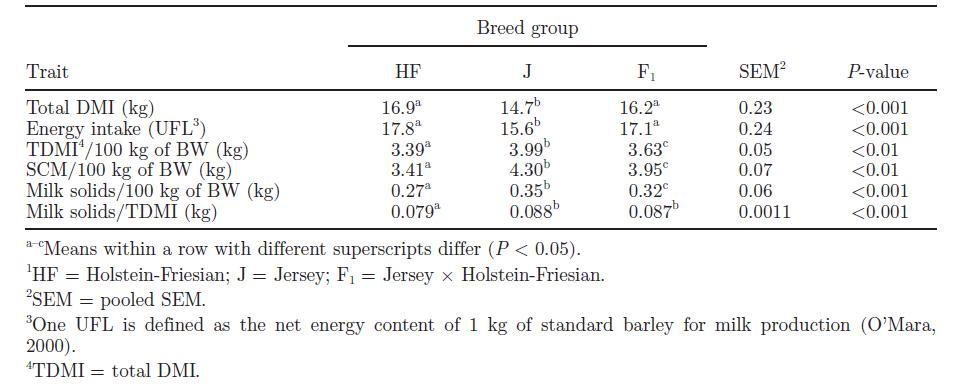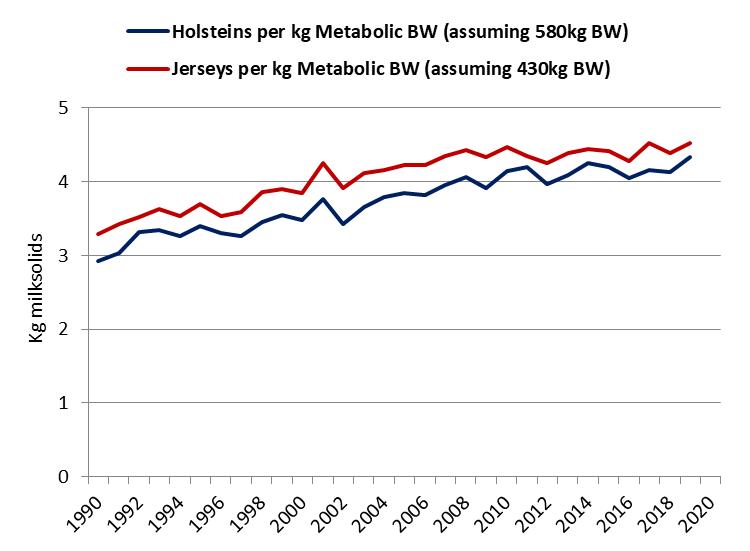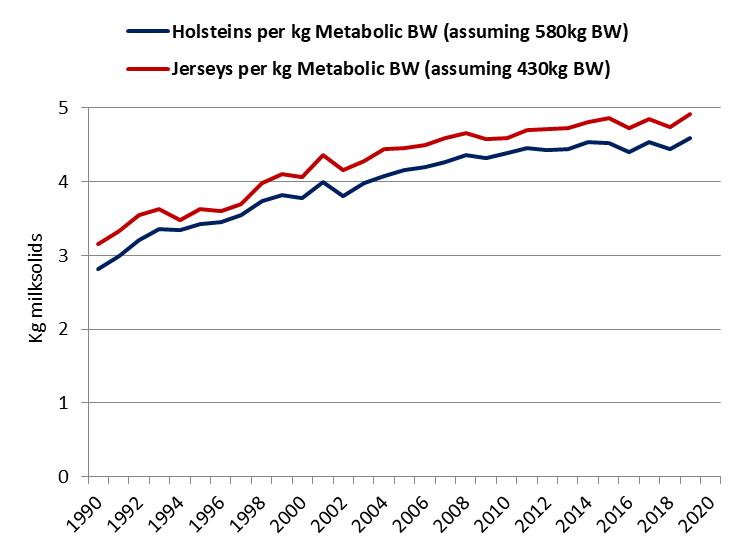
4 minute read
2. Production efficiency
Key points: Studies have found that Jerseys produce 6-11% more energy-corrected milk (ECM) than
Holsteins per kilogram of dry matter intake, and 26-31% more ECM per 100 kg bodyweight than Holsteins. Jerseys are also 8% more energetically efficiency Jersey cows’ higher production efficiency is due to reduction and dilution of their daily maintenance energy requirement Jerseys are performing well in mixed breed herds
Advertisement
When respondents to the Jersey Australia survey were asked to give their level of agreement with the statement ‘Jerseys convert feed into milk more efficiently than other breeds’: 96% agreed or strongly agreed, 2% disagreed or strongly disagreed, and 2% were unsure.
Production efficiency may be expressed and measured in many different ways. Two of the most common measures are the amount of milk solids (MS) or energy corrected milk yield (ECM) per unit of dry matter (DM) intake, and the amount of milk solids (MS) or energy corrected milk yield (ECM) per 100kg bodyweight (BW).
Grainger and Goddard (2004) compiled the results of research studies described in eleven scientific papers and reported that feed conversion efficiency (g MS/kg DM) was generally higher (8 out of 11 comparisons) for the Jersey compared with the Holstein and Friesian cows, averaging about 6.4% higher. (For more details, see Appendix B, Table B.1).
More recent studies confirm the conclusions of Grainger and Goddard (2004) that Jerseys use feed more efficiently than Holsteins. Beecher et al. (2014) found that feed conversion efficiency (g MS/kg DM) of Jerseys on an entirely pasture diet was 16% higher than that of Holsteins. Milk solids yield (kilograms of fat and protein) per 100 kg BW was 0.27 kg for Holsteins but 0.35 kg for Jerseys with the crossbred being intermediate.
A Danish study by Kristensen et al. (2015) compared the efficiency of Holstein, Jersey and other breeds in herds where cows were fed either a total mixed ration or a partial mixed ration and housed in loose housing systems. Jerseys were found to have higher efficiency for six efficiency measures for energy and production, namely: Total energy requirement in percent of NEL intake (NELEFF) Residual feed intake (RFI) Kilograms of ECM per 10 MJ of NEL (ECMNEL) Kilograms of ECM per kilogram of DMI (ECMDMI) Kilograms of ECM per 100 kg of live weight (ECMBW) Kilograms of DM per 100 kg of live weight (DMIBW)
As shown in Table 5., Kristensen et al. (2015) found that Jerseys produced 8% more energycorrected milk (ECM) than Holsteins per kilogram of dry matter intake, and 31% more ECM per 100 kg bodyweight than Holsteins. Jerseys were also 8% more energetically efficient, as measured in kg ECM per 10 MJ of net energy for lactation (NEL).
Table 5. Efficiency measures for energy, production, and environmental load in the group of lactating cows in commercial herds of different breeds [Kristensen et al., 2015].
An Irish, pasture-based study by Prendiville et al. (2009) found similar results to Kristensen et al. (2015). Jerseys produced 11% more energy-corrected milk (ECM) than Holsteins per kilogram of dry matter intake, and 29% more ECM per 100 kg bodyweight than Holsteins. (Table 6.).
Table 6. Effect of dairy cow breed on total DMI, corresponding energy intake, and gross efficiency measures [Prendiville et al., 2009].
Milk production per kg metabolic bodyweight (calculated as body weight to the power of 0.75 (BW0.75) is more useful than milk production per 100 kg, as it is an estimation of the amount of metabolically active tissue in a cow’s body upon which its energy expenditure and basal metabolic rate depend.
Analysis of Australian herd recording data held by DataGene shows that Jerseys produce approximately 9% more milksolids per unit metabolic bodyweight (BW0.75) than Holsteins (Figure 4a,b).


(a)

(b)
Figure 4. Average 305-day milk solids per kg metabolic bodyweight (BW0.75) for cows by year in (a) seasonal and split calving herds, and (b) year-round calving herds [DataGene, 2021].
Energy balances provide a detailed measure of partitioning of energy within the cow, but energy metabolism studies comparing breeds are scarce. Grainger and Goddard (2004) reviewed three studies and found that in two of those studies, heat production was lower in Jerseys, but there were no differences between Jerseys and Holsteins in the more recent study conducted by Tyrrell et al. (1990). More recently, Dong et al. (2015) conducted a meta-analysis on 935 observations that were collated from 32 calorimetric chamber experiments undertaken between 1992 and 2010 at the Agri-Food and Biosciences Institute at Hillsborough, UK. Most of the observations were from Holstein cows, but in a comparison of Holstein versus non-Holstein (includes Norwegian, Jersey X Holstein and Norwegian X Holstein), there was no significant effect between the two different groups of dairy cows on the efficiencies of metabolisable energy use for maintenance or lactation.









